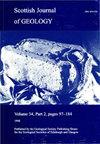Combining ground stability investigation with exploratory drilling for mine water geothermal energy development. Lessons from exploration and monitoring.
IF 1.3
4区 地球科学
Q4 GEOLOGY
引用次数: 0
Abstract
Mine water geothermal's potential for decarbonisation of heating and cooling in the UK has led to increased national interest and development of new projects. In this study, mine water geothermal exploration has been coupled with ground investigation techniques to assess ground stability alongside seasonal mine water hydrogeology and geochemistry. Drilling operations in late 2020 at Dollar Colliery, Clackmannanshire, Scotland, encountered mined coal seams with varying conditions (void, intact, waste, etc.), reflecting different techniques used throughout a protracted mining history. We found that time and resources spent grouting casing through worked mine seams (ensuring hydraulic separation) can be saved by accessing deeper seams where those above are unworked. Continued assessment of existing water discharges and completion of boreholes with slotted liners into mined coal seams and fractured roof strata allowed chemical and water level changes to be monitored across a 1-year period. Mine water heads and mine discharge flow rates vary seasonally and are elevated between late autumn and early spring. The mine water has a low dissolved solute content. Dissolved sulphate- 34 S isotope data suggest increased pyrite oxidation during lower water levels. These findings can inform future building decisions, whereby housing developments on site could use the mine water for heating. Thematic collection: This article is part of the Early Career Research collection available at: https://www.lyellcollection.org/topic/collections/early-career-research Supplementary material: https://doi.org/10.6084/m9.figshare.22188801将地面稳定性调查与勘探钻探相结合用于矿井水地热能开发。勘探和监测的经验教训。
矿井水地热在英国供暖和制冷脱碳方面的潜力增加了国家的兴趣,并开发了新项目。在这项研究中,矿井水地热勘探与地面调查技术相结合,以评估地面稳定性以及季节性矿井水水文地质和地球化学。2020年末,苏格兰克拉克曼南郡多拉尔煤矿的钻井作业遇到了不同条件的开采煤层(空洞、完整、废弃等),反映了长期采矿史上使用的不同技术。我们发现,通过进入上述未加工的较深煤层,可以节省在已加工煤层中灌浆套管(确保水力分离)所花费的时间和资源。对现有排水量的持续评估,以及在开采的煤层和破碎的顶板地层中完成带槽衬管的钻孔,使化学和水位变化能够在一年内得到监测。矿井水头和矿井排水流量随季节变化,在深秋和早春之间升高。矿井水的溶解溶质含量较低。溶解硫酸盐-34S同位素数据表明,在低水位期间,黄铁矿氧化增加。这些发现可以为未来的建筑决策提供信息,根据这些决策,现场的住房开发可以使用矿井水供暖。主题集:本文是早期职业研究集的一部分,可在以下网站获取:https://www.lyellcollection.org/topic/collections/early-career-research补充材料:https://doi.org/10.6084/m9.figshare.22188801
本文章由计算机程序翻译,如有差异,请以英文原文为准。
求助全文
约1分钟内获得全文
求助全文
来源期刊

Scottish Journal of Geology
地学-地质学
CiteScore
1.70
自引率
0.00%
发文量
10
审稿时长
>12 weeks
期刊介绍:
Although published only since 1965, the Scottish Journal of Geology has a long pedigree. It is the joint publication of the Geological Society of Glasgow and the Edinburgh Geological Society, which prior to 1965 published separate Transactions: from 1860 in the case of Glasgow and 1863 for Edinburgh.
Traditionally, the Journal has acted as the focus for papers on all aspects of Scottish geology and its contiguous areas, including the surrounding seas. The publication policy has always been outward looking, with the Editors encouraging review papers and papers on broader aspects of the Earth sciences that cannot be discussed solely in terms of Scottish geology.
The diverse geology of Scotland continues to provide an important natural laboratory for the study of earth sciences; many seminal studies in geology have been carried out on Scottish rocks, and over the years the results of much of this work had been published in the Journal and its predecessors.
The Journal fully deserves its high reputation worldwide and intends to maintain its status in the front rank of publications in the Earth sciences.
 求助内容:
求助内容: 应助结果提醒方式:
应助结果提醒方式:


